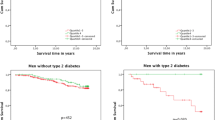Summary
The relationship between lipid, apolipoprotein-B and testosterone concentration and indicated coronarography was followed in male patients assigned into two age groups (under and over 50 years). Patients without a positive finding on coronary vessels served as controls. Patients of both age groups with a positive coronarographic finding showed an enhanced apolipoprotein-B and a decreased cholesterol concentration in the HDL2-high density lipoprotein subfraction. Like-wise, testosterone level was also decreased in the two age groups. It appears that a lowered testosterone level may indirectly intervene into lipoprotein metabolism, or may affect the apolipoprotein-B level.
Similar content being viewed by others
Abbreviations
- HDL:
-
high density lipoprotein
- HDL-Ch:
-
high density lipoprotein-cholesterol
- LDL:
-
low density lipoprotein
- LPL:
-
lipoprotein lipase
- VLDL:
-
very low density lipoprotein
References
Anderson DW, Nichols AV, Pan SS, Lindgren FT (1978) High density lipoprotein distribution. Resolution and determination of three major components in a normal population sample. Atherosclerosis 29:161–179
Berchtold P, Berger M (1978) HDL-Cholesterin, ein Schutzfaktor gegen die koronare Herzkrankheit. Dtsch Med Wochenschr 103:1537–1540
Carlson LA (1963) Determination of serum triglycerides. J Atheroscler Res 3:33–36
Chait A, Albers JJ, Brunzell JD (1980) Very low density lipoprotein overproduction in genetic forms of hypertriglyceridemia. Eur J Clin Invest 10:17–22
Curry MD, Gustafson A, Alaupovic P, McConathy WJ (1978) Electroimmunoassay, radial evaluated for quantification of human apolipoprotein-B. Clin Chem 24:280–286
Glueck CJ, Scheel D, Fishback J, Steiner P (1972) Progestagens anabolic-adrogenic compounds, estrogens: effects on triglycerides and postheparin lipolytic enzymes. Lipids 7:110–113
Gofman JW, Young W, Tandy R (1966) Ischemic heart disease atherosclerosis and longevity. Circulation 34:679
Goldstein JL, Brown MS (1974) Binding and degradation of low density lipoproteins by cultured human fibroblasts. J Biol Chem 249:5153–5162
Goldstein JL, Brown MS (1977) The low density lipoprotein pathway and its relation to atherosclerosis. Ann Rev Biochem 46:897–930
Gutai J, LaPorte R, Kuller L, Dai FW, Flavo-Gerard L, Caggiula A (1981) Plasma testosterone, high density lipoprotein cholesterol and other lipoprotein fractions. Am J Cardiol 48:897–902
Haffner SM, Rampratap S, Kushwaha S, Foster DM, Applebaum-Bowden D, Hazzard WR (1983) Studies on the metabolic mechanism of reduced high density lipoproteins during anabolic steroid therapy. Metabolism 34:413–420
Havel RJ, Eder HA, Bragdon JH (1955) Distribution and chemical composition of ultracentrifugally separated lipoproteins in human serum. J Clin Invest 34:1345–1353
Hazzard WR, Kushwaha RS, Applebaum-Bowden D, Haffner SM, Steinmetz A, Foster DM (1984) Chylomicron very low-density lipoprotein apolipoprotein-B metabolism: Mechanism of the response to stanozolol in a patient with severe hypertriglyceridemia. Metabolism 33:873–881
Hromadová M, Háčik T, Riečanský I (1982) Plasma apolipoprotein-B in male patients examined by angiography. 4th Dresden Symposium International Symposium on Lipoproteins and Atherosclerosis June 10–12, 1982, Dresden GDR, pp 150–153
Kannel WB (1974) The role cholesterol in coronary atherogenesis. Med Clin North Am 58:363–379
Mendoza SG, Osuna A, Zerpa A, Gartside PS, Glueck CJ (1981) Hypertriglyceridemia and hypoalfalipoproteinemia in azoospermatic and oligospermatic young men: relationships of endogenous testosterone to triglyceride and high density lipoprotein cholesterol metabolism. Metabolism 30:481–486
Mertz DP (1978) Vasoprotektive und vasoaggressive Eigenschaften von Lipoproteinen in Serum. Münch Med Wochenschr 120:1671–1672
Mertz DP (1980) Atherosclerose Index (LDL/HDL): Risikoindikator bei Störungen des Fettstoffwechsels. Med Klinik 75:159–161
Nörday A, Aakvaag A, Thelle D (1979) Sex hormones and high density lipoproteins in healthy males. Atherosclerosis 34:431–436
Patsch JR, Gotto AM (1979) Die Rolle der HDL im Katabolizmus triglyceridreicher Lipoproteine. Internationales Symposium: Neue Aspekte Diagnostik und Therapie von Fettstoffwechselstörungen 12–13 Mai 1979, Wien
Phillips GB (1977) Relationship between serum sex-hormones and glucose, insulin and lipid abnormalities in men with myocardial infraction. Proc Nat Acad Sci USA 74:1729–1733
Reuter W (1978) Sekundäre Hyperlipoproteinämien. Z Gesamte Inn Med 33:817–822
Reuter W, Herrmann W (1981) Klinische Bedeutung des HDL-Cholesterols. Z Gesamte Inn Med 36:473–479
Rudel LL, Morris MD (1973) Determination of cholesterol using o-phtalaldehyde. J Lipid Res 14:364–366
Singurdsson G, Nicoll A, Lewis B (1976) Metabolism of very low density lipoproteins in hypetriglyceridemia: studies of apolipoprotein-B kinetics in man. Eur J Clin Invest 6:167–177
Solyom A (1972) Effects of androgens on serum lipids and lipoproteins. Lipids 7:100–105
Šeböková E, Kolena J (1978) Characterization of specific prostaglandin E1 receptor in isolated rat Leydig cells. Endocrinol Exp 12:147–156
Vander Heiden GL, Barboriak JJ, Sasse EA, Yorde DE (1984) Correlation of the extent of coronary occlusion with apo-B levels. Atherosclerosis 50:29–33
Whayne ThF, Alaupovic P, Curry MD, Lee ET, Anderson PS, Schechter E (1981) Plasma apolipoprotein B and VLDL-, LDL-, and HDL-cholesterol as risk factors in the development of coronary artery disease in male patients examined by angiography. Artherosclerosis 39:411–424
Author information
Authors and Affiliations
Rights and permissions
About this article
Cite this article
Hromadová, M., Háčik, T. & Riečanský, I. Concentration of Lipid, apoprotein-B and testosterone in patients with coronarographic findings. Klin Wochenschr 63, 1071–1074 (1985). https://doi.org/10.1007/BF01739675
Received:
Accepted:
Issue Date:
DOI: https://doi.org/10.1007/BF01739675




